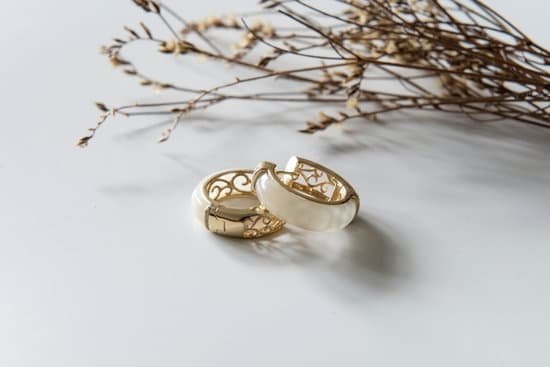Introduction
Jewelry markings are a series of symbols and letters used to signify information about specific pieces of jewelry. These marks can tell the designer, metal type, country of origin, and more. They are also known as hallmarks, stamps, assay marks, maker’s marks and/or sponsor’s marks. Identifying these markings accurately is important for both collectors and appraisers as they help determine the history, value and authenticity of a particular piece of jewelry. Knowing how to identify and interpret these markings can provide valuable insight into the age and worth of your jewelry.
There are several ways one can go about identifying the various jewelry markings they come across. First, it is important to keep an eye out for official hallmarking centers in goldsmiths or other trade councils where registered trademarks will be present. This may require some research on local laws and regulations concerning metalworking or hallmarking in a particular region or country. Additionally, researching older antique pieces or searching online databases or forums that specialize in identifying vintage estates can provide further insight into any unknown markings you come across. With that said, some modern pieces have minimal-to-no information concerning their origin – if the item physically looks different from what you expected from the description provided by the vendor then it’s best to avoid such items altogether due to safety concerns associated with counterfeit goods produced by unknown artisans. Finally, many jewelers offer an appraisal service which helps determine not only a piece’s authenticity but also its current market value should you ever decide to resell it one day.
Understand Unique Hallmarks & Maker’s Marks
It is important to familiarize yourself with the various jewelry markings you may come across when identifying your pieces. Every piece of jewelry contains markings that indicate where and when it was made and by whom. Common markings include hallmarks, the unique stamps or indications left on a piece of jewelry by a maker or assayer; maker’s marks which are signature stamps or initials used to identify the creator; purity marks which denote the grade of gold or silver used in a particular piece; assay marks that can tell you where a piece was manufactured; hallmark office stamps that note the country or authority which registered the hallmark, along with its date and other information; design numbers and style codes which identify individual designs and manufacturing information from serial numbers to gemstone weight and origin details. A trusted jeweler can help to decipher these documents, so be sure to contact them about any pieces you are unsure about for additional guidance.
Differentiating Gold, Silver, Platinum & Pure Metal Jewelry Markings
When trying to identify jewelry markings, it is important to know the differences between gold, silver, platinum, and pure metal jewelry. This will help determine the authenticity of a piece and inform you as to its origin. Gold marks typically feature a number followed by a letter indicating what type of gold is in the jewelry piece: 10k indicates that the jewelry is made with 10-karat gold; 14k shows 14-karat gold; 18k means 18-karat gold; 22k demonstrates 22-karat gold. Silver marks usually feature either an “S” or “Ag” followed by numbers indicative of how many parts per thousand are silver (for instance 999 meaning 99.9% silver). Platinum also has numerical markings with corresponding letter codes such as Pt900 or PT950 denoting 90% pure or 95% pure platinum respectively. Pure metal jewelry should be marked with “M,” indicating that this piece contains no alloys and is made from pure metal like copper or brass.
Analyzing Diamond & Other Precious Stone Identifications
When it comes to jewelry markings, the first step is to identify the type of stone your piece contains. Diamonds, sapphires, emeralds, rubies and other precious stones are often marked with hallmarks or stamps on their settings. These marks will usually include information such as the manufacturer, carat weight and purity of the stone. Depending on where you have purchased the item, you may also find information about its value. Other less expensive pieces of jewelry may carry simple marks indicating the gold or silver content of the metal used in its making.
Once you have identified the type of gemstone used in your jewelry piece, you can begin to analyze its markings further. Diamonds are often accompanied by a GIA (Gemological Institute of America) certificate that contains details about cut, color and clarity which indicate its overall grade and quality. The diamond’s carat weight can also be found along with an inscription that identifies which company or individual did the cutting and polishing. It’s important to ask your jeweler for their opinion as they may be able to provide additional information about your diamond from a professional perspective.
Companies who manufacture semi-precious stones such as quartz and jade typically use standardized industry markings to designate grades and qualities within each type of gemstone. For example, quartz might be categorized according to “AA” (for top-grade quartz), “A” (for good quartz), “B” (for average quartz), “C” (for lower grade quartz). Similarly symbolic etchings or stamps on silver-plated items indicate their metal content while sterling silver is normally produced with an engraved hall mark indicating it is 92.5% pure silver alloyed with 7.5% base metal alloyed components (generally copper). Jewelry markings can help aid identification but must always be taken together with other indications —in particular evaluations by qualified experts—to ensure accuracy and authenticity when researching specific items or making buying decisions
Investigating Symbology on Jewelry & Its Meaning
When identifying your jewelry markings, it is important to pay particular attention to any symbols or engravings engraved or stamped into the metal. Carefully inspect these markings as they often provide clues to its origin and composition. Depending on the type of jewelry item in question, marks may vary; however there are a few universal jewelry marks that every collector should know. These include hallmarks, maker’s marks, trademarks, and purity marks (such as karat stamps or numbers).
Hallmarks indicate the manufacture of the piece, maker’s marks signify who made it, trademarks give ownership information such as the jewelry brand if known, while purity marks list the quality of metal used in its construction. Additionally symbols can also typically be found on vintage pieces denoting the period of time in which it was created and what style it is inspired by (ie: Art Deco or Edwardian). Furthermore motifs and gemstones can often point towards a certain era as well.
In order to distinguish which mark pertains to which category examine both the shape of each one and their presence along with an accompanying letter or initials. For instance crown stamping may denote a maker’s mark whereas an ‘18Kt’ stamp would identify a piece as having 18 karat gold purity rating. Likewise most modern day designer signatures will appear in written form rather than image so use any accompanying text clues carefully when deciphering meaning from markings on your jewelry items.
Comparing Assay Office & Emblematic Markings
When identifying jewelry markings, it’s important to look for Assay Office Marks and Emblematic Markings. Assay Office marks are stamps that indicate where a piece of jewelry was assayed, or tested by an independent laboratory. This mark will often be accompanied by a number indicating the year in which the piece was hallmarked. On gold items, this stamp is usually at least 18K to guarantee that the item is made of solid gold. Emblematic marks are symbols used to identify the maker of a piece of jewelry or indicate the origin country of manufacture. The hallmark system originated centuries ago in England and today each country has its own hallmarking laws with different symbols for various elements like gold, silver, and platinum as well as finishing techniques like Rhodium plating. Often those marks include initials unique to the maker, allowing you to trace information about a particular artist or jeweler who crafted it. Identifying emblematic marks can provide additional information such as age and history surrounding a particular piece – facts that may significantly increase its value!
Examining Serial Numbers & How to Track Origin of Jewellery
One of the most common questions people ask when trying to identify their jewelry is how to locate and decipher any markings that may be on it. There are many types of markings that can exist and often times the age, style and origin of a piece can be determined from these. One type of marking that one might find upon a piece of jewelry could be a serial number. Serial numbers often appear upon manufactured jewelry such as costume pieces or mass-produced items and can provide information about when and where the item was made. These numbers can also help you determine whether your piece is an authentic product as well as provide information about customer service, warranty and more.
Other markings one might come across while examining a piece of jewelry could include maker’s marks, hallmarks, manufacturer’s logos or even artist signatures – these are often indicative of the origin or maker/artist of a particular item as well as clues to its original country/region or era in which it was made. Maker’s marks are usually visual indicators such as an insignia or logo with identifying features like shapes and lines – each mark has it’s own unique symbolism and meaning associated with it. Hallmarks on the other hand would typically signify the purity level of either gold, silver or platinum used in making a particular item while artist signatures indicate who created the piece – sometimes there may even be multiple signatures indicating collaboration between more than one designer. Ultimately, if you wish to fully identify your jewelry markings, then researching your specific maker/creator online or consulting an experienced jeweler may offer additional insight into potential origins, ages or creator’s identity.
Detecting Fakes & Imitations of Jewelry Markings
One of the best ways to identify authentic jewelry markings is to look for manufacturer’s marks. Each piece of jewelry typically has a mark that identifies the maker. They are usually embossed, etched, or punched into metal or stone and can take different forms. Some common examples include monograms, trade names, initials, or symbols. Generally, these marks will be accompanied by a logo or display the company name. Be sure to research any mark you find in order to ensure that it is authentic and made by an original manufacturer and not a knockoff.
Another way to tell if your jewelry piece is real is by inspecting the craftsmanship and materials used. Check for signs of wear such as scratches on metals or loose stones on settings that may have been caused by artificial copies. Take note of any inconsistencies in size or color in order to see if they don’t reflect what they should be with a genuine product. High-quality metals like gold and platinum will also have official stamps with purity levels noted on them based on their alloy makeup and weight, so make sure that these stamps match with whatever shines back at you in the mirror when wearing your jewelry piece too!
Knowing Where & How to Look for Your Jewelry Markings
Identifying the markings on your jewelry is an important part of being able to determine its value and authenticity. Being able to identify jewelry markings can also help you in your search for specific items or pieces that might have a higher or lower value due to their uniqueness and rarity.
The best place to begin is with the piece’s hallmarks, which are usually located on the inside of a ring, bracelet or necklace, as well as inside the clasp of a brooch. If a piece has been inscribed with a signature, it is likely that it was made cordially by one of the most renowned jewelers of the period whose techniques and craftsmanship are still appreciated today. Identifying these signatures can give incredible insight into the origin of a particular piece and how rare it may be in comparison to other pieces from different eras.
You should always look at the back of any gemstones and examine them carefully; many vintage pieces feature gems engravings, such as “14K”, “925” or “platinum” signifying different levels of purity or various other types of jewelry makers marks. Understanding what each marking stands for can give an invaluable tip off about where and when an item was made which could increase its current value significantly. It is not just professionally-made jewelry that features markings either; craft made pieces often have very distinctive styles, details and stamps alluding to their origin too.
Finally, another source of information are labels and tags commonly found on costume jewelry from designer brands who sign their work out of tradition– these labels can help add further credibility to the authenticity and history behind your piece while ensuring they remain identifiable if ever lost or stolen.
Conclusion
Identifying jewelry markings can be a tricky and challenging experience, but by understanding the basics of such markings, individuals can easily begin to understand and identify them. Jewelry markings are meant to provide information about the piece in question, with many signifying the metal type or purity of the item. These symbols can primarily be found on the clasp of the necklace, bracelet, earring or ring. Markings may also be present directly on gemstones inlaid within these pieces. It is important to closely inspect every part of each piece for potential clues regarding its origin, construction and value.
In addition to closely examining your jewelry for possible marks and symbols, you may also look up the item online in order to provide more insight into its history and authenticity. This method paired with visual examination are most beneficial when identification is needed. Specialized appraisers can also be consulted if attached paperwork is unavailable or lost due to wear over time. Finally, it is important to remember that while jewelry marks can sometimes be difficult to decipher, understanding them is usually easier than it appears – all it takes is a bit of research!

Welcome to my jewelry blog! My name is Sarah and I am the owner of this blog.
I love making jewelry and sharing my creations with others.
So whether you’re someone who loves wearing jewelry yourself or simply enjoys learning about it, be sure to check out my blog for insightful posts on everything related to this exciting topic!





